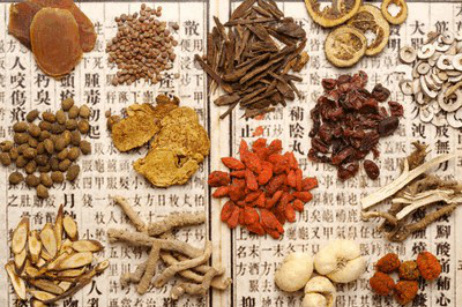
Herbal medicine is an important treatment modality of Traditional Chinese Medicine (TCM) and is probably more widely used in China than acupuncture. It was largely unavailable in Australia before the mid 1980s, when an influx of immigration brought with it Chinese doctors and pharmacists.
Chinese Herbal Medicine actually translates as Chinese Drug Therapy in Chinese because it uses a wide variety of substances. Plant, animal and mineral substances are all included in the Materia Medica of Chinese Herbal medicine. The earliest uses date back at least 3,000 years to the Shang dynasty. Characters representing medicinal substances have been found carved into bone fragments and turtle shells.
The earliest Chinese Pharmacopeia is the Shen Nong Ben Cao, written in the 1st and 2nd centuries AD, with 365 entries—252 of plant origin, 67 of animal and 46 mineral. Today there are over 400 Chinese herbs suitable for use in Australia which have well-documented and understood functions. Chinese herbs are said to regulate the function of internal organs, enhance the immune system and to balance the Yin-Yang (life forces).
International research has shown that the functions of some herbal combinations are similar in action to chemical synthetic drugs for killing bacteria, restraining viruses, relieving fever, stopping pain, balancing hormones, reducing blood glucose levels, etc. There is insufficient evidence to suggest that these actions are applicable in vivo (ie. real people), but this is not actually how Chinese Medicine is traditionally applied either.
Chinese Herbal Medicine is often reported in the media as the cause for the illegal harvesting of rare and endangered plants and animals such as rhino horn and tiger parts. These are often a part of traditional folk medicines, not TCM. Any endangered species are now substituted by alternative substances. With international monitoring in place, any threatened species are banned from being harvested and distributed throughout China and Asia.
Herbal treatment includes: dry herbs to be taken as tea, tablet and capsule format, as well as powders, creams and lotions for external use. Often used in conjunction with acupuncture, Chinese herbs can have powerful therapeutic effects. The success of using Chinese herbal medicine, however, depends heavily on the correct prescription of formulae according to a precise TCM diagnosis.
Chinese herbs are generally used as combinations of ingredients that are known to enhance each other’s functions. A formula may contain between two and twenty herbs depending on the patient’s presentation. As with acupuncture, the focus of the treatment is on balancing the whole clinical picture, rather than focusing on the symptoms.
Raw herbs are prepared at home and taken as a liquid decoction. They are harder to prepare and often bitter, but are stronger, faster acting and more specifically tailored to the patient. Freeze-dried granule concentrates are now also available, as are dozens of traditional formulae in pills and tablets to enable patients to fit treatment into a busy lifestyle.
Throughout the history of TCM there have been many different philosophical directions in the theories of Chinese Herbal Medicine. Its development was closely associated with and heavily influenced by the Taoist tradition and the search for immortality, while acupuncture was more closely aligned with the Confucian tradition. The experiences of thousands of scholars over the course of a couple of thousand years have all contributed to the development of contemporary Chinese Medicine in use throughout the world today.
Chinese Herbal Medicine actually translates as Chinese Drug Therapy in Chinese because it uses a wide variety of substances. Plant, animal and mineral substances are all included in the Materia Medica of Chinese Herbal medicine. The earliest uses date back at least 3,000 years to the Shang dynasty. Characters representing medicinal substances have been found carved into bone fragments and turtle shells.
The earliest Chinese Pharmacopeia is the Shen Nong Ben Cao, written in the 1st and 2nd centuries AD, with 365 entries—252 of plant origin, 67 of animal and 46 mineral. Today there are over 400 Chinese herbs suitable for use in Australia which have well-documented and understood functions. Chinese herbs are said to regulate the function of internal organs, enhance the immune system and to balance the Yin-Yang (life forces).
International research has shown that the functions of some herbal combinations are similar in action to chemical synthetic drugs for killing bacteria, restraining viruses, relieving fever, stopping pain, balancing hormones, reducing blood glucose levels, etc. There is insufficient evidence to suggest that these actions are applicable in vivo (ie. real people), but this is not actually how Chinese Medicine is traditionally applied either.
Chinese Herbal Medicine is often reported in the media as the cause for the illegal harvesting of rare and endangered plants and animals such as rhino horn and tiger parts. These are often a part of traditional folk medicines, not TCM. Any endangered species are now substituted by alternative substances. With international monitoring in place, any threatened species are banned from being harvested and distributed throughout China and Asia.
Herbal treatment includes: dry herbs to be taken as tea, tablet and capsule format, as well as powders, creams and lotions for external use. Often used in conjunction with acupuncture, Chinese herbs can have powerful therapeutic effects. The success of using Chinese herbal medicine, however, depends heavily on the correct prescription of formulae according to a precise TCM diagnosis.
Chinese herbs are generally used as combinations of ingredients that are known to enhance each other’s functions. A formula may contain between two and twenty herbs depending on the patient’s presentation. As with acupuncture, the focus of the treatment is on balancing the whole clinical picture, rather than focusing on the symptoms.
Raw herbs are prepared at home and taken as a liquid decoction. They are harder to prepare and often bitter, but are stronger, faster acting and more specifically tailored to the patient. Freeze-dried granule concentrates are now also available, as are dozens of traditional formulae in pills and tablets to enable patients to fit treatment into a busy lifestyle.
Throughout the history of TCM there have been many different philosophical directions in the theories of Chinese Herbal Medicine. Its development was closely associated with and heavily influenced by the Taoist tradition and the search for immortality, while acupuncture was more closely aligned with the Confucian tradition. The experiences of thousands of scholars over the course of a couple of thousand years have all contributed to the development of contemporary Chinese Medicine in use throughout the world today.
